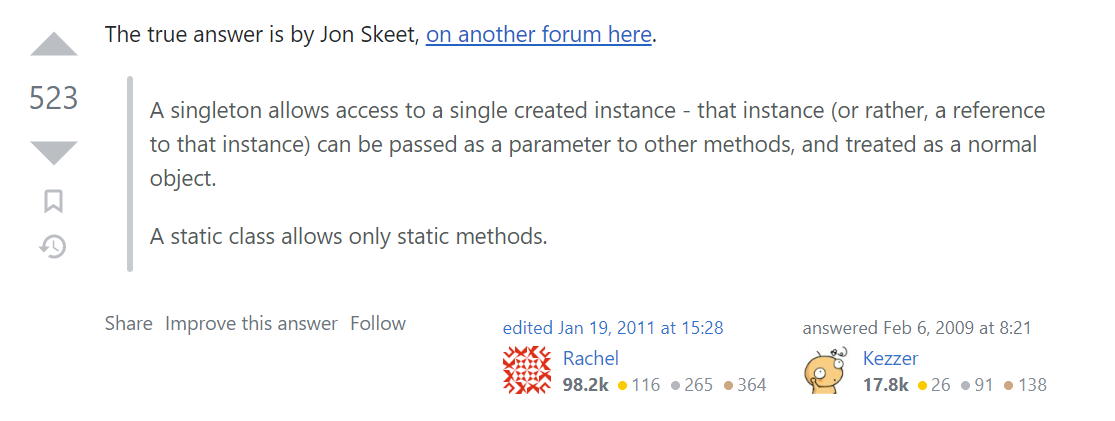CPSC 210
D6: Singleton Pattern


Learning Goals
- To apply the Singleton Design Pattern to a given problem

Example Motivation
I want to coordinate a state across my system. For this purpose, I create a class for my state.
How do I make sure there is always only one instance of my State class in my system?

public class WifiState {
private int numberOfClients;
private int mbDownloadVolume;
private int mbUploadVolume;
public WifiState() {}
// setters
}// ...somewhere in code...
// State state = new WifiState();
// state.setNumberOfClients(30);
// ...// ...somewhere in code...
// How do I get the current state?The Singleton Pattern
Gang of Four: "Ensure a class only has one instance, and provide a global point of access to it."
Wikipedia: "Design pattern that restricts the instantiation of a class to one 'single' instance. This is useful when exactly one object is needed to coordinate actions across the system."
The Singleton Pattern (2)

public class WifiState {
private int numberOfClients;
private int mbDownloadVolume;
private int mbUploadVolume;
public WifiState() {}
// setters
}public class WifiState {
private static WifiState INSTANCE;
private int numClients = 0;
private int mbDownloadRate = 0;
private int mbUploadRate = 0;
private WifiState() {}
public static WifiState getInstance() {
if (INSTANCE == null) {
INSTANCE = new WifiState();
}
return INSTANCE;
}
}Lecture Ticket
public class Unique {
private static Unique singleton = new Unique();
public static Unique getInstance() {
return singleton;
}
private String pithyStatement = "original";
private int quoteCount = 0;
private Unique() { }
public String quote() {
quoteCount++;
return pithyStatement;
}
public void setPithyStatement(String stmt) {
pithyStatement = stmt;
}
public int getQuoteCount() {
return quoteCount;
}
}// REQUIRES: u.getQuoteCount() == 0.
public void manipulate(Unique u) {
Unique u1 = u;
Unique u2 = Unique.getInstance();
System.out.println(u.quote());
if (u2 == u1) {
u2.setPithyStatement("clone");
}
System.out.println(u1.quote());
if (u2.quote().equals(u.quote())) {
u1.setPithyStatement("question");
}
System.out.println(u.quote());
System.out.println(u1.quote());
System.out.println(u2.quote());
System.out.println(u.getQuoteCount());
System.out.println(u1.getQuoteCount());
System.out.println(u2.getQuoteCount());
}What will a correct call to manipulate print, in order?
Example: We already seen it!

The Alarm System!
Let's have a look...
/**
* Represents a log of alarm system events.
* We use the Singleton Design Pattern to ensure that there is only
* one EventLog in the system and that the system has global access
* to the single instance of the EventLog.
*/
public class EventLog implements Iterable<Event> {If you want to dig deeper...
- We could also implement a global state as a static class

If you want to dig deeper...

Lecture Lab

Highlander (THE ONE HIGHLANDER):
/>___________________________________
[########[]_________________________________/
/>
Highlander (THE ONE HIGHLANDER):
/>___________________________________
[########[]_________________________________/
/>Desired Output
Highlander (Joe's Highlander):
/>___________________________________
[########[]_________________________________/
/>
Highlander (Sue's Highlander):
/>___________________________________
[########[]_________________________________/
/>Actual Output
- Joe and Sue are playing the Highlander game
- But there are multiple Highlanders



D6: Singleton Pattern
The End - Thank You!
CPSC210 - D6: Singleton
By Steven Wolfman
CPSC210 - D6: Singleton
- 230



